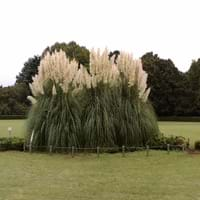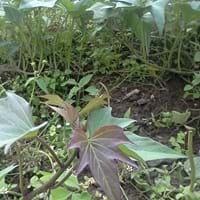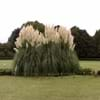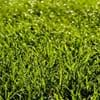Life Span
Annual or Biennial
Annual and Perennial
Type
Grass
Bulb or Corm or Tuber
Origin
South America, Micronesia, New Zealand
Latin America and the Caribbean, Central America, Micronesia
Types
Silver pampas grass, Uruguayan pampas grass, Purple pampas grass
Hannah Yams, Japanese Sweet Potatoes
Number of Varieties
Not Available
Habitat
Lawn
Cold Regions, Tropical regions
USDA Hardiness Zone
7-11
11-12
AHS Heat Zone
11 - 7
12-1
Sunset Zone
H1, 3a, 3b, 4, 5, 6, 7, 8, 9, 10, 11, 12, 13, 14, 15, 16, 17, 18, 19, 20, 21, 22, 23, 24
21,22
Habit
Clump-Forming
Vining/Climbing
Minimum Width
Not Available
Flower Color
Pink, Violet, White hair and some brown spots on margins and at tips
Not Available
Flower Color Modifier
Bicolor
Bicolor
Fruit Color
Not Available
Not Available
Leaf Color in Spring
Green, Light Green, Dark Green
Green, Purple, Light Green, Chartreuse, Bronze
Leaf Color in Summer
Light Green
Light Green
Leaf Color in Fall
Green, Light Green, Dark Green
Several shades of Green
Leaf Color in Winter
Dark Green, Tan
Light Green
Leaf Shape
Long and slender with very sharp edges
Heart-shaped
Plant Season
Spring, Summer, Fall, Winter
Spring, Summer, Fall, Winter
Sunlight
Full Sun
Full Sun, Partial Sun
Growth Rate
Fast
Very Fast
Type of Soil
Loam
Clay, Loam, Sand
The pH of Soil
Acidic, Neutral
Acidic, Neutral, Alkaline
Soil Drainage
Well drained
Well drained
Bloom Time
Summer, Fall
Late Fall, Early Winter, Winter
Tolerances
Drought, Salt
Drought
Where to Plant?
Ground
Ground, Pot
How to Plant?
Seedlings, Stem Planting
Stem Cutting, Tuber propagation
Plant Maintenance
Low
Medium
Watering Requirements
Average Water Needs, Needs watering once a week, Reduce water once established, Water more frequently during periods of extreme drought
Average Water Needs, Needs a lot of water initially
In Summer
Lots of watering
Lots of watering
In Spring
Moderate
Moderate
In Winter
Average Water
Average Water
Soil pH
Acidic, Neutral
Acidic, Neutral, Alkaline
Soil Type
Loam
Clay, Loam, Sand
Soil Drainage Capacity
Well drained
Well drained
Sun Exposure
Full Sun
Full Sun, Partial Sun
Pruning
Prune in late winter, Remove branches, Remove damaged leaves, Remove dead branches, Remove dead leaves, Remove deadheads
Remove damaged leaves, Remove dead branches, Remove dead leaves
Fertilizers
Apply 10-10-10 amount, Nitrogen, Phosphorous, Potassium
All-Purpose Liquid Fertilizer
Pests and Diseases
Red blotch
Aphids, Beetles, Leafminers, Red blotch
Plant Tolerance
Drought, Salt
Drought
Flower Petal Number
Single
Single
Foliage Texture
Fine
Coarse
Foliage Sheen
Matte
Matte
Invasive
Sometimes
Sometimes
Attracts
Birds, Rats, Snakes
Aphids, Beetles, Mites, white worms
Allergy
Itchiness, Skin cuts
Abdominal pain, Skin rash, Swelling, Vomiting
Aesthetic Uses
Showy Purposes
Not Used For Aesthetic Purpose
Beauty Benefits
Not Available
Not Available
Edible Uses
Insignificant
Yes
Environmental Uses
Air purification, Provides ground cover
Air purification
Medicinal Uses
Not Available
Potassium, ß-carotene, Vitamin C
Part of Plant Used
Flowers, Leaves
Leaves, Root, Shoots
Other Uses
Fibre, Food for animals, Used in paper industry
Used As Food, Used for its medicinal properties
Used As Indoor Plant
Insignificant
Yes
Used As Outdoor Plant
Yes
Yes
Garden Design
Dried Flower / Everlasting, Cutflower, Dried Flower/Everlasting, Feature Plant, Foundation, Groundcover, Mixed Border, Screening / Wind Break
Container, Edible, Groundcover, Hanging Basket, Herb / Vegetable, Mixed Border, Vine
Botanical Name
CORTADERIA
IPOMOEA batatas
Common Name
Pampas Grass
Sweet Potato, Sweet Potato Vine
In Hindi
Pampas grass
शकरकंद
In German
Pampasgrass
Süßkartoffel
In French
herbe de la pampa
Patate douce
In Spanish
cortaderas
Batata
In Greek
γρασίδι Πάμπα
Γλυκοπατάτα
In Portuguese
grama de Pampas
Batata doce
In Polish
Pampas trawy
Słodki ziemniak
In Latin
Pampas herba
Dulcis SOLANUM TUBEROSUM
Phylum
Vascular plant
Magnoliophyta
Class
Liliopsida
Magnoliopsida
Family
Poaceae
Convolvulaceae
Clade
Angiosperms, Commelinids, Monocots
Angiosperms, Asterids, Eudicots
Tribe
Danthonieae
Not Available
Subfamily
Danthonioideae
Not Available
Importance of Pampas Grass and Sweet Potato
Want to have the most appropriate plant for your garden? You might want to know the importance of Pampas Grass and Sweet Potato. Basically, these two plants vary in many aspects. Compare Pampas Grass and Sweet Potato as they differ in many characteristics such as their life, care, benefits, facts, etc. Every gardener must at least have the slightest clue about the plants he wants to plant in his garden. Compare their benefits, which differ in many ways like facts and uses. The medicinal use of Pampas Grass is Not Available whereas of Sweet Potato is Potassium, ß-carotene and Vitamin C. Pampas Grass has beauty benefits as follows: Not Available while Sweet Potato has beauty benefits as follows: Not Available.
Compare Facts of Pampas Grass vs Sweet Potato
How to choose the best garden plant for your garden depending upon its facts? Here garden plant comparison will help you to solve this query. Compare the facts of Pampas Grass vs Sweet Potato and know which one to choose. As garden plants have benefits and other uses, allergy is also a major drawback of plants for some people. Allergic reactions of Pampas Grass are Itchiness and Skin cuts whereas of Sweet Potato have Abdominal pain, Skin rash, Swelling and Vomiting respectively. Having a fruit bearing plant in your garden can be a plus point of your garden. Pampas Grass has showy fruits and Sweet Potato has no showy fruits. Also Pampas Grass is flowering and Sweet Potato is not flowering . You can compare Pampas Grass and Sweet Potato facts and facts of other plants too.





